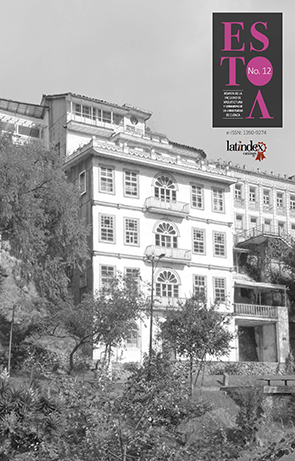The ruin as a proyect. Strategies in the work of Sou Fujimoto
DOI:
https://doi.org/10.18537/est.v007.n012.a09Abstract
In the Romanticism, the representation of the ruin in the landscape served to open the feeling of nature and the need to find the natural beauty of the architecture since the return to origins. In the work of Japanese architect Sou Fujimoto, arises again a search of the primitive or as originating in which the concept of "ruin" takes an action potential for the future, which is discovered by the feeling of nature and its interaction with the man to recover the true meaning of inhabiting.
Keywords: Architecture, Indeterminacy, Nature, Ruin, Sou Fujimoto.Downloads
References
Conde, Yago (2000). Arquitectura de la Indeterminación. Actar, Barcelona.
Eisenman, Peter (1984). El Fin de lo clásico, el Fin del comienzo, o el fin del fin. Arquitecturas Bis, nº 48, p. 28-36.
Fujimoto, Sou. (2008). Primitive Future. Contemporary Architect’s Concept Series 1 (1ª Ed.). Tokio, INAX Publishing.
Heidegger, Martin (1954). Bauen, Wohnen, Denken, en Vorträge und Aufsätze, Verlag Günther Neske, Pfullingen. Version española, Construir Habitar Pensar, en Conferencias y Artículos. Ed. Del Serbal, Barcelona, 1997.
Sou Fujimoto (2010). Futuro Primitivo. El Croquis Sou Fujimoto, nº 151, p.198-213.
Ito, Toyo (1999). Vórtice y corriente. Arquitectura como fenómeno. Exit LMI, nº 5, p. 67-69.
Ito, Toyo (2006). Arquitectura de límites difusos. GG mínima, Barcelona.
Ito, Toyo (2000). Escritos. Murcia.
Ito, Toyo (2009). Arquitectura teórica y sensorial: los experimentos radicales de Sou Fujimoto. 2G Sou Fujimoto, nº 50, p. 4-9.
Laugier, P. (MDCCCLV). Essay sur l´Architecture. Nouvelle edition. A Paris. Chez Duchesne.
Marchán Fiz, Simón (1985). La poética de las ruinas, un capítulo casi olvidado en la historia del gusto. Fragmentos, nº 6, p. 4-15.
Marchán Fiz, Simón (2008). Las Querellas modernas y la extensión del arte. Fabrikart: arte, tecnología, industria y sociedad, nº 8, p. 14-34.
Nishida, Kazuyo (2001). El concepto japonés del espacio doméstico. Pasajes de arquitectura y crítica. Especial Japón. Septiembre 2001, nº 29, p. 60-62.
Rykwert, Joseph (1974). La Casa de Adán en el Paraíso. GG, Barcelona.
Semper, Gottfried (1851). Die vier Elemente der Baukunst. Braunschweig.
Taki, Koji (1976). 生きられた家:経験と象徴 (Ikirareta ie: Keiken to shōchō). 岩波書店.
Towse, Pablo y Pancorbo, María (2010). La tensión del vacío. Engawa nº 00, p. 5-9.
Worrall, Julian (2009). La importancia de Sou Fujimoto. 2G Sou Fujimoto, nº 50, p. 10-23.
Published
How to Cite
Issue
Section
License
The Journal declines any responsibility for possible conflicts derived from the authorship of the works that are published in it.
The University of Cuenca in Ecuador conserves the patrimonial rights (copyright) of the published works and will favor the reuse of the same ones, these can be: copy, use, diffuse, transmit and expose publicly.
Unless otherwise indicated, all contents of the electronic edition are distributed under a Creative Commons Attribution-NonCommercial-ShareAlike 4.0 International License.




